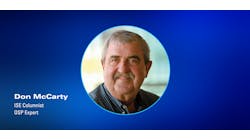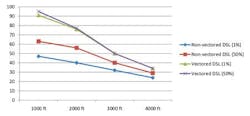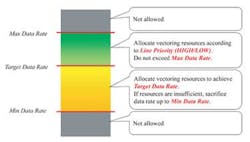Fiber Speeds on Copper Lines? It’s True!
by: George Ginis, Mehdi Mohseni, and John M. Cioffi
(This article originally ran in the April 2010 issue of OSP Magazine)
[dropcap]V[/dropcap]ectored DSL technology is able to mitigate the crosstalk effects that form the most serious performance bottleneck for dense deployments of DSL lines operating in the very-high-speed region (above 15 Mbps). (See Reference A.) Major DSL chipset vendors recently presented results from Vectored DSL system prototypes (See Reference B.), confirming the very substantial performance gains that were predicted by earlier theory. The standard for Vectored DSL has now been published (See Reference C.), with field trials and initial deployments expected to materialize in the next two years.
Dynamic Spectrum Management (DSM) with Vectored DSL technology, also known as DSM Level 3, can also provide substantial improvements in plant diagnostics. Problem location and isolation occurs rapidly and often automatically, and the information about the loop plant becomes very accurate and detailed. As such, DSM-Vectored DSL can greatly improve the efficiency of maintenance and operation of the DSL services within the plant, as well as simultaneously double or triple the achievable customer DSL speeds.
[pullquote]
This article provides a brief overview of the Vectored DSL technology and its benefits. It further describes the implications of Vectored DSL deployment for Operations and Maintenance (OAM) practices, and explains how proper management practices employing DSM principles can maximize the benefits of Vectored DSL.
[/pullquote]Vectored DSL Fundamentals
Crosstalk can be a significant noise source in multi-pair copper cables used for DSL transmission. Crosstalk becomes a dominant noise source in DSL systems that make use of higher frequencies and that operate over short loop lengths (shorter than 6,000 ft).1 Very-high-speed DSL (VDSL) can use frequencies up to 30 MHz (See Reference D.), as opposed to the various flavors of Asymmetric DSL (ADSL), which are limited to 1.104 or 2.208 MHz, and are designed for operation over relatively long loops. VDSL is particularly vulnerable to crosstalk for both the downstream and the upstream transmission directions; its data rate performance is typically limited by Far-End-Crosstalk (FEXT). This means that in practical deployments, where multiple pairs are sharing the same cable and are thus causing crosstalk into each other, data rates over a single-pair are limited to no higher than around 70 Mbps for downstream and no higher than around 40 Mbps for upstream, even with loops as short as 500 ft.
Vectored DSL uses advanced signal processing techniques to mitigate or even completely eliminate crosstalk. Although the techniques used for downstream transmission differ from those used for upstream transmission, in both cases, signal processing functions are no longer performed on a line-by-line basis, but are performed jointly among a group of lines at the DSL Access Multiplexer (DSLAM). When crosstalk can be mitigated or eliminated, loop plant engineering can be made much more efficient using the information provided by a Vectored DSL system (as well as seeing speeds increase).
Figure 1. Illustration of Vectored DSL for downstream transmission.
The DSLAM signal processing for Vectored DSL for downstream transmission is illustrated in Figure 1. The figure shows a simplified example of only two DSL lines connected to the same DSLAM (or Access Node), and causing FEXT into each other.2 The digital data streams to be transmitted on each line are entering the Access Node on the left, and the analog signals are applied on the copper lines through the Analog-Front-Ends (AFE) of the Access Node on the right. For each line, the data stream is first encoded,3 it is subsequently modulated,4 and it is finally transmitted through the AFE on the copper medium as an analog signal. When Vectored DSL is enabled, the outputs of the encoding modules are used to pre-compensate for the FEXT that will be experienced on the copper lines. In other words, the FEXT is pre-subtracted at the Access Node, so that after the signals travel through the copper lines, the signals received at the Customer Premises Equipment (CPE) are free of crosstalk.
Figure 2. Illustration of Vectored DSL for upstream transmission.
Similarly, the DSLAM signal processing for Vectored DSL for upstream transmission is displayed in Figure 2, again for a simple example of 2 DSL lines. In addition to the lines causing FEXT into each other, it is also shown how both lines may be affected by some external but common noise source (alien crosstalk). The signal flow is now the reverse of the signal flow for downstream, with the analog signals entering the Access Node through the AFE on the right, and the digital data streams leaving the Access Node on the left. The operations of decoding and demodulating are the counterparts of the encoding and modulating for downstream. With Vectored DSL enabled, the outputs of the demodulation modules are used to cancel the FEXT that resulted from transmission through the copper pairs. In addition, the outputs from the decoding modules can be "fed-back" to allow for the mitigation of alien crosstalk (this technique is often referred to as decision feedback or successive decoding). The result of this action is elimination of a major impairment to DSL, not only increasing speeds, but improving the ability to manage the loop plant, which may include non-Vectored DSLs in addition to Vectored DSLs.
Performance Benefits
The effect of crosstalk is not uniform across DSL lines; it becomes stronger as the loop lengths become shorter, and as higher frequencies are used. Moreover, the performance impact of crosstalk on a given line depends on the number and on the strength of crosstalk sources. At a more detailed level, the degradation experienced by a given line as a result of crosstalk depends on whether there are neighboring DSL lines that are sharing the same cable (or sharing part of the cable), on the relative proximity of these neighboring lines to the given line, and on the transmission power levels used by these neighboring lines.
As a result of the above, the data rate performance of non-Vectored DSL can have a very wide variation in the field, especially for the shorter loops, where crosstalk dominates. The crosstalk cancellation achieved by Vectored DSL significantly reduces this variation, and makes it possible to offer the higher rates to a larger percentage of the installed lines. Thus outside plant management can be consequently simplified.
Figure 3. Downstream data rates (in Mbps) for non-Vectored and Vectored DSL. Data rates are shown for 1%-worst-case and for 50%-worst-case (median).
Figure 3 compares the downstream data-rate performance for single-pair vectored and non-Vectored DSL for loop lengths between 1,000 feet and 4,000 feet. These rates were obtained by simulation using standardized models for crosstalk coupling. It was assumed that there are 2 binders, each with 25 pairs. Of the total 50 pairs, 24 are used for DSL service. When vectoring is enabled for these 24 lines, it was assumed that crosstalk originating from the 18 worst-disturbing pairs can be fully removed. In order to capture the effect of different pair positions within the binders, results were derived for a large number of random pair selections, so that quantities could be derived for both a 1%-worst-case and for a 50%-worst-case (median). For a fully detailed explanation of the simulation assumptions (See Reference E.), which is also the original source of these results.
There are two important conclusions that can be drawn from Figure 3:
1. The use of Vectored DSL reduces the data rate variation among pairs in a binder affected by crosstalk. Vectored DSL is in effect achieving the equivalent of crosstalk-free transmission for all pairs.
2. Vectored DSL pushes the data rates to the region of 100 Mbps. Unlike other broadband access technologies that share the available bandwidth among multiple customers, this is dedicated bandwidth that is available to each customer individually. Such rates become practical with Fiber-to-the-Curb (FTTC) architectures and can be offered over a single twisted pair.5
Five Implications on OSP Operations and Maintenance
The deployment of Vectored DSL systems has important implications on Operations and Maintenance (OAM) practices. The benefits shown in the previous section are maximized when such OAM practices are enhanced to account for the new effects and capabilities introduced by Vectored DSL. A summary of how these practices can be updated is below:
Implication #1: Fault Detection and Service Prediction
Vectored DSL systems can report through the management interface the crosstalk coupling among pairs. (See Reference E.) The availability of this quantity (also known as XLOG) leads to the following capabilities:
Crosstalk Diagnosis
The XLOG quantity makes it possible to identify lines that create excessive crosstalk. Typically, such lines are characterized by faults (e.g., poor balance) that lead to poor performance and that are prime targets for maintenance actions. It is possible that such pairs also generate crosstalk into non-vectored lines (which cannot be eliminated). By identifying such extreme crosstalk “polluters”, and then taking action based on such information, the copper network can be improved over time. This can substantially reduce the time spent by technicians in trying to identify an offensive noisy line that is degrading all its neighbors by identifying which exact line is the most likely culprit.
Performance Prediction
The knowledge of the XLOG quantity allows for more accurate prediction of the expected gains from FEXT cancellation. Knowing the expected gains provides essential guidance for choosing the line priorities (see next sub-section), and to determine if a service upgrade is feasible. This allows tuning of the DSLs to the demand for data rate and services among the customers, as per the ensuing section on Line Prioritization.
Implication #2: Line Prioritization
The signal processing operations of vectoring are such that it is possible to direct the performance benefits towards certain lines. The management interface 0 allows the service provider indirect control of the computational resources and of the signal processing operations of vectoring, for example to favor a line that is being offered a higher-end service. The configuration parameters that can be manipulated for this purpose are the minimum data rate, target data rate, maximum data rate and the line priority. The rules governing these parameters are illustrated in Figure 4. The best practice is to configure these quantities individually for each line, based on both the line’s capabilities and the service requirements.
Figure 4. Configuring line priorities and data rate configuration parameters.
Implication #3: Coexistence Among Vectored and Non-Vectored DSL Lines
It is possible that non-vectored and vectored lines share the same binder; for example, if legacy DSLAMs are not replaced as newer vectored DSLAMs are installed. In such cases, the crosstalk generated from the non-vectored lines to the vectored lines cannot be cancelled. If left unmanaged, such crosstalk will reduce the benefits of crosstalk cancellation performed among the vectored lines. The proper management practice is then to reduce the transmitted power levels of the non-vectored lines to a level no higher than what is the minimum required to maintain their service requirements. Any such adjustment of the transmitted power levels must be made on a line-by-line basis, after taking into account the conditions under which each line operates.
Implication #4: Management of Non-Crosstalk Noise Sources
Non-crosstalk noise sources can be of two types, where each type has a different effect on Vectored DSL systems. These are described next, together with a short explanation of the proper management actions:
Noise sources that become dominant after crosstalk is removed.
One example of such a source is impulsive noise that is normally masked by crosstalk, and that starts affecting performance only after vectoring is enabled. A second example is shifting background noise that may lead to line re-initialization. The prevention of such disruptions requires management algorithms that appropriately configure each line for impulse noise protection, or for coping with abrupt noise changes.
Noise sources that cannot be mitigated through vectoring.
In some cases of downstream transmission, it is not possible to cancel certain noise sources through vectoring. Such noise sources may include AM noise, various types of Radio-Frequency-Interference (RFI), or crosstalk from legacy DSL systems. Typically, such sources affect a specific set of frequencies. If such a set of frequencies is found to be affected from this kind of interference, the proper management action is to instruct the Vectored DSL system to disable vectoring over those frequencies (See Reference F.), so that vectoring computational resources are directed to more productive uses.
Implication #5: Management of Vectored DSL
The OAM practices that were recommended in the previous section for Vectored DSL can be implemented as part of a DSL management system, such as DSL Expresse® offered by ASSIA, Inc. Such a system supports an efficient and automated way to apply the following process across all lines in a DSL network:
- Collecting operational and performance parameters from the DSL equipment, and storing these parameters for long periods of time (days to weeks).
- Analyzing the stored parameters to either detect physical layer faults (e.g., copper impairment), or to obtain performance projections.
- Taking action based on the analysis results and based on the line’s service requirements , where such action may include reconfiguring the line (e.g., to improve stability or to increase rates), or reporting on faults and service quality (e.g., to facilitate maintenance).
- This process is another component of Dynamic Spectrum Management (DSM). (See Reference G.) The management techniques and interfaces specific to Vectored DSL are collectively called DSM Level 3.
In summary, the deployment of a management system compliant with DSM Level 3 enables the DSL service provider to maximize the benefits of Vectored DSL, while controlling maintenance costs.
Endnotes
1. This statement applies for DSL systems that are not experiencing impulse noise, or for DSL systems for which DSM Level 1 management principles have been applied to mitigate such impulse noise.
2. When FEXT originates from lines within the same vectored group, it is called “In-domain FEXT”.
3. Encoding includes operations such as framing, forward error correction coding, interleaving, and mapping to transmission symbols.
4. Modulation includes operations such as applying a Fast-Fourier-Transform, adding a cyclic extension and windowing.
5. Note that the results shown here assume use of only 8 MHz for VDSL transmission; extension to 17 MHz or even 30 MHz (as allowed by the standards) further increases the achievable data rates.
References
A. G. Ginis and J. M. Cioffi, “Vectored transmission for digital subscriber line systems,” IEEE J. Select. Areas. Comm., vol. 20, no. 5, pp. 1085-1104, June 2002.
B. J. M. Cioffi, K. Fisher, A. Clausen, M. Peeters, P.-E. Eriksson, G. Ginis, The Path to 100 Mbps DSL Services, IEEE Globecom 2009, Access Forum, Session 203, December 2009.
C. Self-FEXT Cancellation (Vectoring) for use with VDSL2 transceivers, ITU-T Recommendation G.993.5 (g.vector), January 2010.
D. Very high speed digital subscriber line transceivers 2, ITU-T Recommendation G.993.2, January 2010.
E. ASSIA, Actelis, “VDSL2 FEXT Cancellation Performance Evaluation in Remote Deployments”, ITU-T contribution B07-05-37, Geneva, Switzerland, June 2007.
F. Physical Layer Management for Digital Subscriber Line (DSL) Transceivers, ITU-T Recommendation G.997.1, January 2010.
G. Dynamic Spectrum Management, ATIS NIPP-NAI Technical Report, ATIS-PP-0600007
About the Authors
George Ginis is currently Vice President of Expresse Software with ASSIA, Inc., overseeing development and deployment of the DSL Expresse management product. Between 2002 and 2005, he was a Systems Engineer at the Broadband Communications Group of Texas Instruments, where he was involved in the design of DSL chipsets for central office equipment and residential gateways. He holds a Diploma in Electrical and Computer Engineering from the National Technical University of Athens, and M.S. and Ph.D. degrees in Electrical Engineering from Stanford University.
Mehdi Mohseni joined ASSIA, Inc., in 2006 as a Systems Architect focused on DSL network optimization and improving management systems. His research interests incorporate multi-user information theory and optimization of wireless and broadband networks using convex optimization techniques. Mohseni holds a Bachelor’s degree in Electrical Engineering from Sharif University of Technology, Tehran, Iran, as well as M.S. and Ph.D. degrees in Electrical Engineering from Stanford University.
John M. Cioffi is founder and CEO of ASSIA, Inc, and Professor Emeritus at Stanford University. He has more than 30 years of experience with high performance digital transmission, both in research and in business, and is the recipient of numerous prestigious awards for his contributions to technology and industry.
ASSIA, Inc. (Adaptive Spectrum and Signal Alignment Incorporated) is a provider of high-performance software tools for the emerging high growth marketplace referred to as Dynamic Spectrum Management (DSM). ASSIA’s technology and software employ several adaptive learning methods to characterize each DSL line, the various employed modem products, and the local and overall DSL network to reduce operational costs for the Service Provider, increasing DSL network data rates and thereby raising customer satisfaction. For more information, visit www.assia-inc.com.








